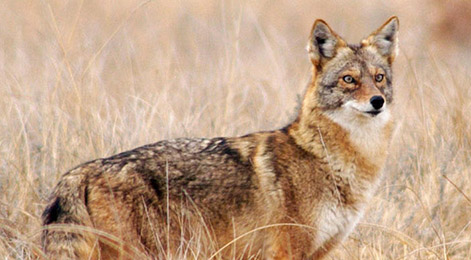Responses of Small Mammals and Their Predators to Military Disturbance in Tallgrass Prairie
 Investigators:
Investigators:
Jonathan Conard, M.S. Student
Project Supervisor:
Dr. Philip S. Gipson
Funding:
U.S. Department of Defense
Collaborators:
Dr. Jeffrey Pontius
Dr. Kimberly With
Location:
Fort Riley, Kansas
Completion:
2003
Status:
Completed
Objectives:
Assess the influence of military disturbance on small mammals and their mammalian and diurnal avian predators.
Results:
Small mammals and their mammalian and avian predators were studies in grassland habitat at Fort Riley, Kansas. The impact of military disturbance on small mammals was examined by trapping on flour plots in heavily disturbed areas and four plots in lightly disturbed areas during winter, spring, summer fall (2002), and winter (2003). Vegetation was surveyed on the small mammal trapping plots for the fall (2002) and winter (2003) seasons to determine how vegetation structure impacted small mammal abundance and diversity. Each small mammal trapping whole plot (300 m x 300 m) included four subplots with different trap densities. Each subplot was 100 m x 100 m and was randomly assigned a trap density of 9 traps stations/ha, 16 trap stations/, 25 trap stations/ha, or 36 trap stations/ha, with two live traps at each station. Relative abundance, species richness, Shannon diversity (H'), catch/unit effort, and community composition of small mammals were compared between densities.
Mammalian predators were surveyed seasonally using two tracking stations baited with fatty-acid scent tabs on each small mammal trapping plots. Avian predators were surveyed seasonally using a 10 km road survey in the lightly disturbed area and one in the heavily disturbed area.
Species richness was lower in the heavily disbursed area during fall and winter (2002) (P < .05). Abundance of Peromyscus maniculatus, Reithrodontomys megalotis, and Microtus ochrogaster did not differ between heavily and lightly disturbed areas. Blarina hylophaga and Sigmodon hispidus were consistently more abundant in lightly disturbed areas. Shannon diversity (H') and species evenness (J') were not detectably different between areas during any season. Trap density was positively related to species richness and relative abundance, but negatively related to catch / unit effort. Trap density did not detectably influence estimates of Shannon diversity (H'), seasonal population trends, or proportional abundance of common small mammal species Coyotes (Canis latrans) were the most common mammalian predator detected in all seasons on both areas. Relative abundance of coyotes showed no marked differences between areas during any season. Diurnal raptor survey indicated generally higher raptor abundances in the heavily disturbed area during all seasons.
Products:
Thesis or Dissertation:
Conard, J.M. 2003. Responses of small mammals and their predators to military disturbance in tallgrass prairie. Master's Thesis. Division of Biology, Kansas State University. (Advisor: Gipson).
Professional Presentations:
Gipson, P. S., J. M. Conard, and A. B. Anderson. 2006. Annual American Society of Agronomy International Meeting. The role of munitions-impacted sites on military lands as refugia for wildlife. Platform presentation.
Conard, J. M., and P. S. Gipson. 2004. 65th Annual Midwest Fish and Wildlife Conference. Micro-habitat use by elk in the tallgrass prairie of east central Kansas. Platform presentation.
Gipson, P. S., J. M. Conard, and J. Baumgardt. 2004. 84th Annual Meeting of the American Society of Mammalogists. Coyote and diurnal raptor presence in relation to military training and small mammal abundance. Poster.
Conard, J. M., P. S. Gipson, J. S. Pontius, and G. L. Zuercher. 2003. 83rd Annual Meeting of the American Society of Mammalogists. The influence of trap density, vegetation structure, and anthropogenic disturbance on measures of small mammal diversity. Platform presentation.